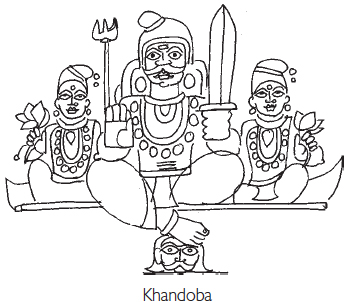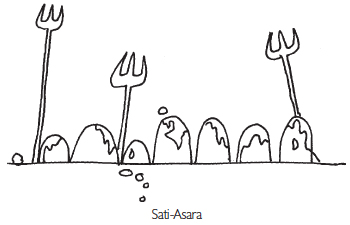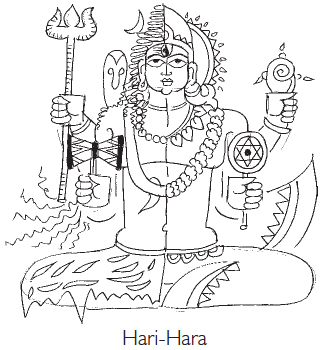myth = mithya: a handbook of hindu mythology
Devdutt Pattanaik
Pattanaik, Devdutt;
myth = mithya: a handbook of hindu mythology
Penguin 2006, 227 pages
ISBN 9780143099703
topics: | india | myth | philosophy
i found this book with my sister-in-law, who is heavily into myth. I read a few pages of the introduction, and was instantly hooked to the originality and power of the argument. Perhaps others had said this before, but I hadn't come across such a clear statement for the role of myth in our lives, how myth constituted the background reality for most of our everyday actions and beliefs. At the time I was reading up on the 1857 war of independence, also known as the Mutiny. I found in postcolonial literature a re-evaluation of the history of the mutiny and was struck by how much the reconstruction of the mutiny in british eyes was not very much different from a mythological narrative. In particular, the attempts to blow up events - by introducing fantastic tales of sepoys raping british women and deliberately cutting down britishers who had been promised safe pasage. it is the grotesqueness of these stories, that like a ten-headed demon, that gives myths its staying power and makes it memorable. From the myths come truths - beliefs that guide our lives, such as the myth of the impossibility of indian self-governance and hence the role for british rule. Many Indians also believed this to be the case. Thus myths become the truths of our lives. This is why even a historian such as Eric Stokes, trained in objectivity, cannot overcome the mutiny myths, and he on visiting the Sati Chaura ghat, he finds "the air seems loaded with menace." Patnaik is also a fine artist, and his pencil sketches of the gods work well to enliven the story. Not surprising at all how this book is such a best-seller.
Excerpts
Introduction
Everybody lives in myth. This idea disturbs most people, for conventionally, myth means falsehood. Nobody likes to live in falsehood... But there are many types of truths, subjective as well as objective. Some logical, some intuitive, some cultural, some universal. Some depend on evidence, others on faith. Myth is truth which is subjective, intuitive, cultural and grounded in faith. [In Greek philosophy, mythos, distinguished from logos. From logos came science and mathematics; "logic" is etymologically from logos. mythos gave rise to the oracles and the arts. Logos explained how the sun rises and how babies are born. But it never explained why a baby is born, why does man exist on earth? For answers to these we turn to mythos. Mythos gave purpose, meaning, and validation to existence. In sanskrit, myth was mithya, as opposed to sat. mithya was truth seen through a frame of reference. sat was truth independent of any viewpoint. mithya gave a limited, distorted view of reality, sat a limitless, correct view of things. Myth was a delusion, open to correction. 2 Myth is essentially a cultural construct, a common understanding of the world that binds individuals and communities together. This understanding may be religious or secular. Ideas such as heaven and hell, angels and demons, fate and freewill, sin, satan and salvation are religious myths. Ideas such as sovereignty, nation-state, human rights, women's rights, animal rights and gay rights are secular myths. Secular or religious, myths are truths that we live by. If myth is an idea, mythology is the vehicle of that idea. Mythology constitutes stories, symbols and rituals that make a myth tangible. Stories, symbols and rituals are essentially languages—languages that are heard, seen and performed.Together they construct the truths of a culture.The story of the Resurrection, the symbol of the crucifix and the ritual of baptism establish the idea that is Christianity. The story of independence, the symbol of the national flag and the ritual of the national anthem reinforce the idea of a nation state. Mythology tends to be hyperbolic and fantastic to drive home a myth. It is modern arrogance to presume that in ancient times people actually believed in the objective existence of virgin births, flying horses, parting seas, talking serpents, gods with six heads and demons with eight arms.The sacredness of such obviously irrational plots and characters ensures their flawless transmission over generations. The unrealistic content draws attention to the idea behind the communication. Behind virgin births and parting seas is an entity who is greater than all forces of nature put together. A god with six heads and a demon with eight arms project a universe where there are infinite possibilities, for the better and for the worse. From myth comes beliefs, from mythology customs. Myth conditions thoughts and feelings. Mythology influences behaviours and communications. Myth and mythology thus have a profound influence on culture. Likewise, culture has a profound influence on myth and mythology. People outgrow myth and mythology when myth and mythology fail to respond to their cultural needs. So long as Egyptians believed in the afterworld ruled by Osiris, they built pyramids. So long as Greeks believed in Charon, the ferryman of the dead, they placed copper coins for him in the mouth of the dead. Today no one believes in Osiris or Charon. There are no pyramids or coins in the mouth of the dead. Instead there are new funeral ceremonies spawned by new belief systems, new mythologies based on new myths, each one helping people cope with the painful inevitability and mystery of death. It is ironical that for all the value we give to the rational, life is primarily governed by the irrational. Love is not rational. Sorrow is not rational. Hatred, ambition, rage and greed are irrational. Even ethics, morals and aesthetics are not rational. They depend on values and standards which are ultimately subjective. What is right, sacred and beautiful to one group of people need not be right, sacred and beautiful to another group of people. Every opinion and every decision depends on the prevailing myth. Even perfection is a myth. There is no evidence of a perfect world, a perfect man or a perfect family anywhere on earth. Perfection, be it Rama Rajya or Camelot, exists only in mythology. Yet everyone craves for it. This craving inspires art, establishes empires, sparks revolutions and motivates leaders. Such is the power of myth. This book explores Hindu mythology. Behind the mythology is a myth. Behind the myth a truth: an inherited truth about life and death, about nature and culture, about perfection and possibility, about hierarchies and horizons.This subjective and cultural truth of the Hindus is neither superior nor inferior to other truths. It is simply yet another human understanding of life.
ch 1: The circle of Brahma and Saraswati
A Hindu deity may be just a rock in a cave, a tree growing in an orchard, a river flowing down the plains, a cow wandering in the street, or perhaps an elaborately decorated idol of stone, clay or metal enshrined in a temple.Anything can be God. So long as it can respond to the human condition. In many shrines, deities are given human form merely by placing a pair of eyes and a pair of hands on a rock. Eyes represent sense organs and hands represent action organs. This indicates the deity is conscious, sensitive and responsive. 6 Puja makes gods more personal.There are Ishta-devatas or personal gods, Kula-devatas or family gods, Graha-devatas or household gods, and Grama-devatas or village gods. These gods either protected their worshippers or provided for them. Protector or guardian gods are usually male. Known as viras, or brave ones, they are visualized as mustachioed hypermasculine men who ride horses, brandish swords and spears, kill demons and have the virility to pleasure many wives. Their images are typically placed at the frontiers of villages, keeping out the malevolent forces of the forests that threaten the settlement. Ayyanar is a popular guardian god of the South while Khandoba is well known in the Deccan Plateau.Khandoba. The folk guardian god of the Maratha community. Like all such guardian gods, Khandoba sports a moustache, rides a white horse and swings a sword. He is identified with Shiva. [Among the interesting aspects, even for us who have grown up in the midst of all this, are the vignettes of village religion.] Seven rocks representing seven virgins or seven mothers are found in many parts of India. Found next to rivers or ponds or lakes, under the shade of neem or tamarind or lemon trees, they are worshipped mainly by women seeking children. The seven rocks are never kept in a temple or served by a priest. They are identified merely by the vermilion powder they are smeared with. hari-hara: A composite form of Shiva and Vishnu. Shiva, the ash-smeared ascetic, represents the realized soul who withdraws from the world. Vishnu, the gold-bedecked king, represents the realized soul who participates in the world. The Goddess marries Shiva, the hermit, and makes him a householder. She forces him to open his eyes and see the mirror in her hand. Not by shutting his eyes, but by opening them can God see himself. The Goddess is the object, the mirror, the world. God is the subject, the reflection, the self. Without her, he cannot know himself. Without him, she has no purpose. Both validate each other’s existence. God is spirit; Goddess is matter. God is soul; Goddess is substance. God is the observer; Goddess is the observation. God establishes artificial values; Goddess is natural phenomena. God is the divine within all beings; Goddess is the divine around all beings. One cannot exist without the other. Without either, there is neither. ---bio Dr Devdutt Pattanaik studied medicine but decided he loves telling stories better. He feels stories are like Eclair sweets; if you chew long enough, you get a burst of chocolate that is locked inside. So rather than working as a doctor, he decided to write and tell ancient Indian stories and reveal the idea-chocolate locked within them. He believes these stories are the gifts of our ancestors. He has been doing this for a long time and even uses the wisdom of these stories to help businesses. He is currently Chief Belief Officer of Future Group.
amitabha mukerjee (mukerjee [at-symbol] gmail.com) 2011 Jun 03


